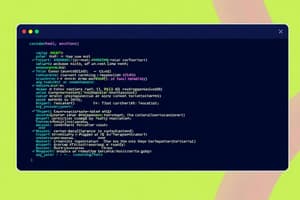Podcast
Questions and Answers
What is the primary function of HTML?
What is the primary function of HTML?
- To add dynamic behavior and interactivity to a webpage.
- To manage server-side operations for a webpage.
- To define the structure and content of a webpage. (correct)
- To style the visual appearance of a webpage.
Which of the following is the correct structure of an HTML element?
Which of the following is the correct structure of an HTML element?
- Content
- ..Content.. (correct)
- Content
- Content
What is the root element in every HTML document?
What is the root element in every HTML document?
- (correct)
- (correct)
- (correct)
- (correct)
Which declaration is required at the beginning of an HTML5 document?
Which declaration is required at the beginning of an HTML5 document?
What is the purpose of HTML attributes?
What is the purpose of HTML attributes?
Which of the following is an example of correct HTML for creating a hyperlink?
Which of the following is an example of correct HTML for creating a hyperlink?
Consider this HTML snippet:``What will be displayed in the browser?
Consider this HTML snippet:``What will be displayed in the browser?
Which of the following characters must be escaped in HTML to display correctly?
Which of the following characters must be escaped in HTML to display correctly?
Examine the following HTML code:
What would be displayed in the web browser?
Examine the following HTML code:
What would be displayed in the web browser?
In HTML, which of the following is the most semantically correct way to represent an abbreviation or acronym?
In HTML, which of the following is the most semantically correct way to represent an abbreviation or acronym?
Which of the following statements accurately describes HTML attributes?
Which of the following statements accurately describes HTML attributes?
What attribute is essential within the <a> tag to create a hyperlink?
What attribute is essential within the <a> tag to create a hyperlink?
Which attributes are recommended for the <img> tag?
Which attributes are recommended for the <img> tag?
What is the primary characteristic of a block-level element in HTML?
What is the primary characteristic of a block-level element in HTML?
Which of the following is an example of a block-level element?
Which of the following is an example of a block-level element?
What distinguishes an inline element from a block-level element?
What distinguishes an inline element from a block-level element?
Which HTML tags are used to define headings?
Which HTML tags are used to define headings?
Which HTML element is used to define a paragraph?
Which HTML element is used to define a paragraph?
Which HTML element is specifically designed for marking up a section of text that is quoted from another source, and is typically rendered with indentation by browsers?
Which HTML element is specifically designed for marking up a section of text that is quoted from another source, and is typically rendered with indentation by browsers?
Consider a scenario where you need to embed an image that, upon being clicked, redirects the user to an external website. Which of the following code snippets would correctly implement this functionality?
Consider a scenario where you need to embed an image that, upon being clicked, redirects the user to an external website. Which of the following code snippets would correctly implement this functionality?
HTML is utilized to dictate the presentation, rather than the structure, of a web page.
HTML is utilized to dictate the presentation, rather than the structure, of a web page.
In HTML, the <html> element must be placed inside the <body> element.
In HTML, the <html> element must be placed inside the <body> element.
The <head> element in HTML is where you place content that is visible to users on the web page.
The <head> element in HTML is where you place content that is visible to users on the web page.
HTML documents must begin with the declaration <!DOCTYPE html>.
HTML documents must begin with the declaration <!DOCTYPE html>.
An HTML element with only a start tag is referred to as a closed element.
An HTML element with only a start tag is referred to as a closed element.
The <div> tag in HTML is considered a structural element, primarily utilized to define a division or a section in an HTML document.
The <div> tag in HTML is considered a structural element, primarily utilized to define a division or a section in an HTML document.
The HTML entity represents a non-breaking space.
The HTML entity represents a non-breaking space.
In HTML, attributes are defined exclusively within the closing tag of an element.
In HTML, attributes are defined exclusively within the closing tag of an element.
In HTML, an empty element is required to have a closing tag for proper rendering by web browsers.
In HTML, an empty element is required to have a closing tag for proper rendering by web browsers.
The direct ancestor of any HTML element with the lang attribute set to en-GB must always have the lang attribute set to en or en-UK
The direct ancestor of any HTML element with the lang attribute set to en-GB must always have the lang attribute set to en or en-UK
All HTML elements must have at least one attribute.
All HTML elements must have at least one attribute.
HTML attributes are specified within the closing tag of an element.
HTML attributes are specified within the closing tag of an element.
In HTML, attributes generally appear as name-value pairs, such as style="value".
In HTML, attributes generally appear as name-value pairs, such as style="value".
The href attribute in the <a> tag specifies the text that will be displayed as the hyperlink.
The href attribute in the <a> tag specifies the text that will be displayed as the hyperlink.
For optimal rendering, the <img> tag requires both width and height attributes to be specified.
For optimal rendering, the <img> tag requires both width and height attributes to be specified.
Block-level elements are displayed inline by default and only take up as much width as necessary.
Block-level elements are displayed inline by default and only take up as much width as necessary.
The <section> tag is an inline element used to define a paragraph.
The <section> tag is an inline element used to define a paragraph.
The <h1> tag represents the least important heading on an HTML page.
The <h1> tag represents the least important heading on an HTML page.
Using the <quotation> tag will indent the quoted text and add citation information.
Using the <quotation> tag will indent the quoted text and add citation information.
The <hyperlink> tag is the correct HTML element to create hyperlinks.
The <hyperlink> tag is the correct HTML element to create hyperlinks.
Flashcards
What is HTML?
What is HTML?
Hyper Text Markup Language, the standard language for creating web pages. It describes the structure of a web page using elements.
What is ?
What is ?
It declares the document type and is always the first tag in an HTML document.
< html > element
< html > element
The root element of an HTML page; it wraps all other elements.
< head > element
< head > element
Signup and view all the flashcards
< title > element
< title > element
Signup and view all the flashcards
< body > element
< body > element
Signup and view all the flashcards
< h1 > element
< h1 > element
Signup and view all the flashcards
< p > element
< p > element
Signup and view all the flashcards
Nested HTML elements
Nested HTML elements
Signup and view all the flashcards
HTML attributes
HTML attributes
Signup and view all the flashcards
Signup and view all the flashcards
![]() width attribute
width attribute
width attribute
Signup and view all the flashcards
![]() height attribute
height attribute
height attribute
Signup and view all the flashcards
Block-level element
Block-level element
Signup and view all the flashcards
Inline element
Inline element
Signup and view all the flashcards
tag
tag
Signup and view all the flashcards
tag
Signup and view all the flashcards
Signup and view all the flashcards
HTML Headings (
to )
HTML Headings (
to )
Signup and view all the flashcards
tag
tag
Signup and view all the flashcards
Web Browsers
Web Browsers
Signup and view all the flashcards
HTML Element
HTML Element
Signup and view all the flashcards
HTML Quotation
HTML Quotation
Signup and view all the flashcards
entity
entity
Signup and view all the flashcards
HTML link
HTML link
Signup and view all the flashcards
Signup and view all the flashcards
![]() width and height attributes
width and height attributes
width and height attributes
Signup and view all the flashcards
< div > element
< div > element
Signup and view all the flashcards
Study Notes
- HTML stands for Hyper Text Markup Language.
- It is the standard markup language for creating web pages
- HTML describes the structure of a webpage.
- HTML consists of a series of elements.
- HTML elements tell the browser how to display the content.
- HTML elements label pieces of content like "this is a heading", "this is a paragraph", and "this is a link".
- Web browsers like Chrome, Edge, Firefox, and Safari read HTML documents used to display them correctly.
- Web browsers utilize HTML tags to determine how the content is displayed.
Simple HTML Document Example
<!DOCTYPE html>: This declaration must start all HTML documents<html>: This tag is the root element of an HTML page.<head>: Contains meta-information about the HTML page.<title>: Specifies a title for the HTML page which will appear in the browser's title bar or tab.<body>: Defines the document's body, and is a container for all the visible content, such as headings, paragraphs, images, hyperlinks, tables, lists, etc.<h1>: Defines a large heading.<p>: Defines a paragraph.
HTML Page Structure
<html>is the root element.<head>contains meta-information like the<title>.<body>contains the content displayed in the browser.- The content inside the
<body>section will be displayed in a browser. - The content inside the
<title>element shows in the browser's title bar or tab.
Special Entity Characters
- HTML uses special characters to display content.
©is the code for the copyright symbol.<is the code for "<".>is the code for ">".&is the code for "&". is the code for space.
HTML Documents
- All HTML documents must start with a
<!DOCTYPE html>declaration. - The HTML document begins with
<html>and ends with</html>. - The visible part of the HTML document is between
<body>and</body>.
HTML Elements
- An HTML element is defined by a start tag, some content, and an end tag:
<tagname> content </tagname> - The HTML element is everything from the start tag to the end tag.
- Some HTML elements have no content and are called empty elements - for example
<br>. - Empty elements do not have an end tag.
Nested HTML Elements
- HTML elements can be nested, meaning elements can contain other elements.
- All HTML documents consist of nested HTML elements.
- The example contains four HTML elements:
<html>,<body>,<h1>, and<p>. <html>is the root element and defines the whole HTML document, with start and end tags.- Inside the
<html>element, there is a<body>.
HTML Attributes
- HTML attributes provide additional information about HTML elements.
- All HTML elements can have attributes.
- Attributes provide additional information about elements.
- Attributes are specified in the start tag.
- Attributes come in name/value pairs like name="value".
- The
<a>tag defines a hyperlink. - The
hrefattribute specifies the URL. For example,<a href="https://www.google.com">Visit google</a> <img>should also contain height and width attributes that specify the height and width of the image<img src="img.jpg" width="500" height="600">
HTML Block and Inline Elements
- Every HTML element has a default display value, depending on what type of element it is.
- A block-level element always starts on a new line and the browsers automatically add some space (a margin) before and after the element.
- Examples of block elements are
<p>and<div>. - Inline elements do not start on a new line, only taking up as much width as necessary.
- Two common block elements are
<p>and<div>. - The
<p>element defines a paragraph. - The
<div>element defines a division or a section. - An inline element doesn't start on a new line and only expands as much width as is necessary.
<span>is an example of an inline element used within a paragraph- Syntax:
<span>Hello World</span>
HTML Headings
- HTML headings are titles or subtitles displayed on a webpage.
- Headings are defined with the
<h1>to<h6>tags. <h1>defines the most important while<h6>is the least important.- Example usages:
<h1>This is heading 1</h1>,<h2>This is heading 2</h2>,<h3>This is heading 3</h3>
HTML Paragraphs
- HTML paragraphs are defined with the
<p>tag. - Example:
<p>paragraph text</p>
HTML Blockquote
<blockquote>defines a section quoted from another source.- Browsers indent
<blockquote>elements. - Example:
<blockquote cite="URL">Text of the quote.</blockquote>
HTML Links
<a>is used to create hyperlinks, allowing users to navigate between pages.- Syntax:
<a href="url">Link text</a> - Absolute links link to other websites, for example
<a href="https://yahoo.com">Yahoo</a>. - Relative links link to pages on the same site, being relative to the current page, for example
<a href="index.html">Home</a>. - The
<a>tag can also create links for email addresses and phone numbers. - For email, use the
mailto:protocol inside thehrefattribute. Clicking opens the default email client with the email address pre-filled.<a href="mailto:[email protected]">This is a link</a> - For phone numbers, use the
tel:protocol to create a call link on mobile devices. - Clicking triggers the phone dialer:
<a href="tel:+97470070070">Call Us</a>
HTML Line Break Element
<br>is a line break element.- It's a stand-alone tag called a void element in HTML5.
- It causes the next element or text to display on a new line.
HTML Horizontal Rule Element
<hr>is a horizontal rule element.- It's a void element.
- It configures a horizontal line on the page.
- Use
hrto indicate a thematic break at the paragraph level in HTML5.
HTML Phrase Elements
- These elements indicate the context and meaning of text.
- They display inline with the text.
<b>displays text in bold font.<strong>has strong importance and is also displayed in bold.<i>displays text in italic font.<em>has emphasis and is also displayed in italic font.
HTML Lists
- HTML lists group a set of related items.
- Three types: unordered, description, and ordered lists
Unordered HTML List
<ul>starts it.<li>begins each list item.- List items are marked with bullets by default`.
- Example:
<ul>
<li>Coffee</li>
<li>Tea</li>
<li>Milk</li>
</ul>
- Output:
- Coffee
- Tea
- Milk
Ordered HTML List
<ol>starts it.<li>tag marks the beginning of each item.- List items are marked with numbers by default.
- Example:
<ol>
<li>Coffee</li>
<li>Tea</li>
<li>Milk</li>
</ol>
- Output:
- Coffee
- Tea
- Milk
HTML Description Lists
- A description list is a list of terms, with a description of each term.
<dl>defines the description list.<dt>defines the term.<dd>describes each term.- Example:
<dl>
<dt>Coffee</dt>
<dd>black hot drink</dd>
<dt>Milk</dt>
<dd>white cold drink</dd>
</dl>
- Output: Coffee black hot drink Milk white cold drink
HTML Div Element
<div>acts as a container for other HTML elements.- It defaults to a block element, taking the full available width with line breaks before and after.
- It can contain other block or inline display elements.
- Multiple
<div>containers are permitted on the same page.
Structural Elements
<header>contains the headings for a page.<nav>contains the main navigation links.<main>holds the main content.<footer>contains the footer information.
HTML Tables
- HTML tables arrange data into rows and columns, best for logically grouped items.
<table>creates a table.<tr>creates table rows.<td>creates data cells within the rows, enclosing the actual presented data. For example:
<table>
<tr>
<td>Month</td>
<td>Sales</td>
</tr>
<tr>
<td>January</td>
<td>$10,000</td>
</tr>
</table>
- Each
<td>and</tr>closing tags may optionally be omitted, and either form of element is valid. <caption>specifies a descriptive table title; it must immediately follow the opening<table>tag.<th>tags are used for row and column headings. For example:
<table>
<caption>Monthly Sales Report</caption>
<tr>
<th>Month</th>
<th>Sales</th>
</tr>
<tr>
<td>January</td>
<td>$10,000</td>
</tr>
</table>
- The "colspan" attribute makes a cell span over multiple columns.
- The "rowspan" attribute makes a cell span over multiple rows.
- Example of Colspan:
<table>
<caption>Monthly Sales Report</caption>
<tr>
<th colspan="2">Name</th>
<th>Age</th>
</tr>
<tr>
<td>Abdullah</td>
<td>Ali</td>
<td>28</td>
</tr>
</table>
- Example of Rowspan:
<table>
<caption>Monthly Sales Report</caption>
<tr>
<th>Day</th>
<th>Time</th>
<th>Event</th>
</tr>
<tr>
<td rowspan="2">Monday</td>
<td>09:00 AM</td>
<td>Meeting</td>
</tr>
<tr>
<td>10:00 AM</td>
<td>Workshop</td>
</tr>
</table>
<thead>and<tfoot>: tables can include special header and footer rows using these tags for additional table information.<tbody>encloses regular table rows when<thead>and/or<tfoot>are used.- Multiple
<tbody>elements can group rows into sections for long tables. - When printed, headers and footers can repeat on each page.
<thead>must appear before<tbody>, but after<caption>(if present) and this enhances table readability & format
Writing Valid HTML
- Check for syntax errors.
- Benefit: valid code results in more consistent browser display.
HTML Validation Tools
- W3C HTML Validation Tool:
http://validator.w3.orgorhttp://validator.w3.org/nu. - Additional HTML5 Validation Tool:
http://html5.validator.nu.
Studying That Suits You
Use AI to generate personalized quizzes and flashcards to suit your learning preferences.




